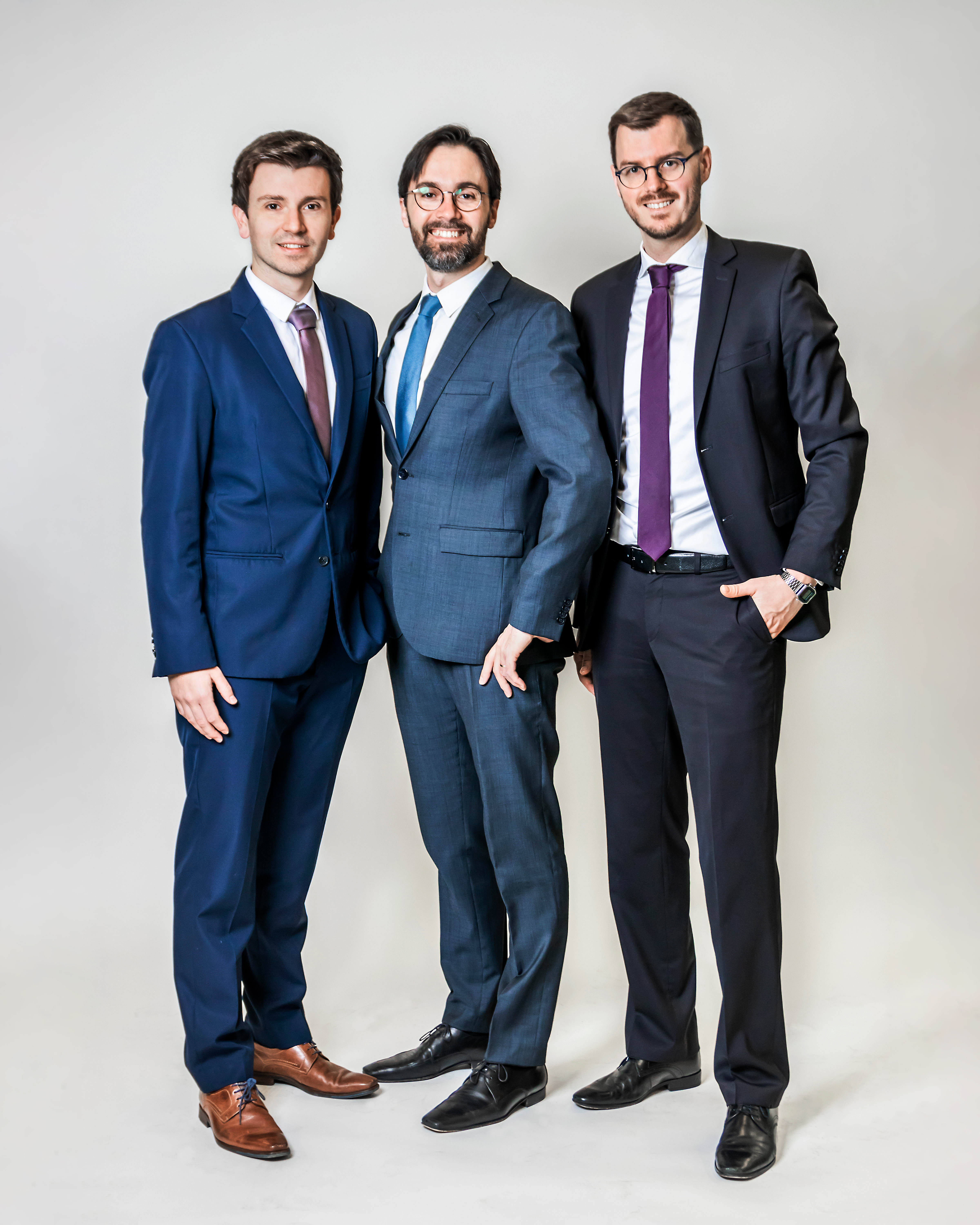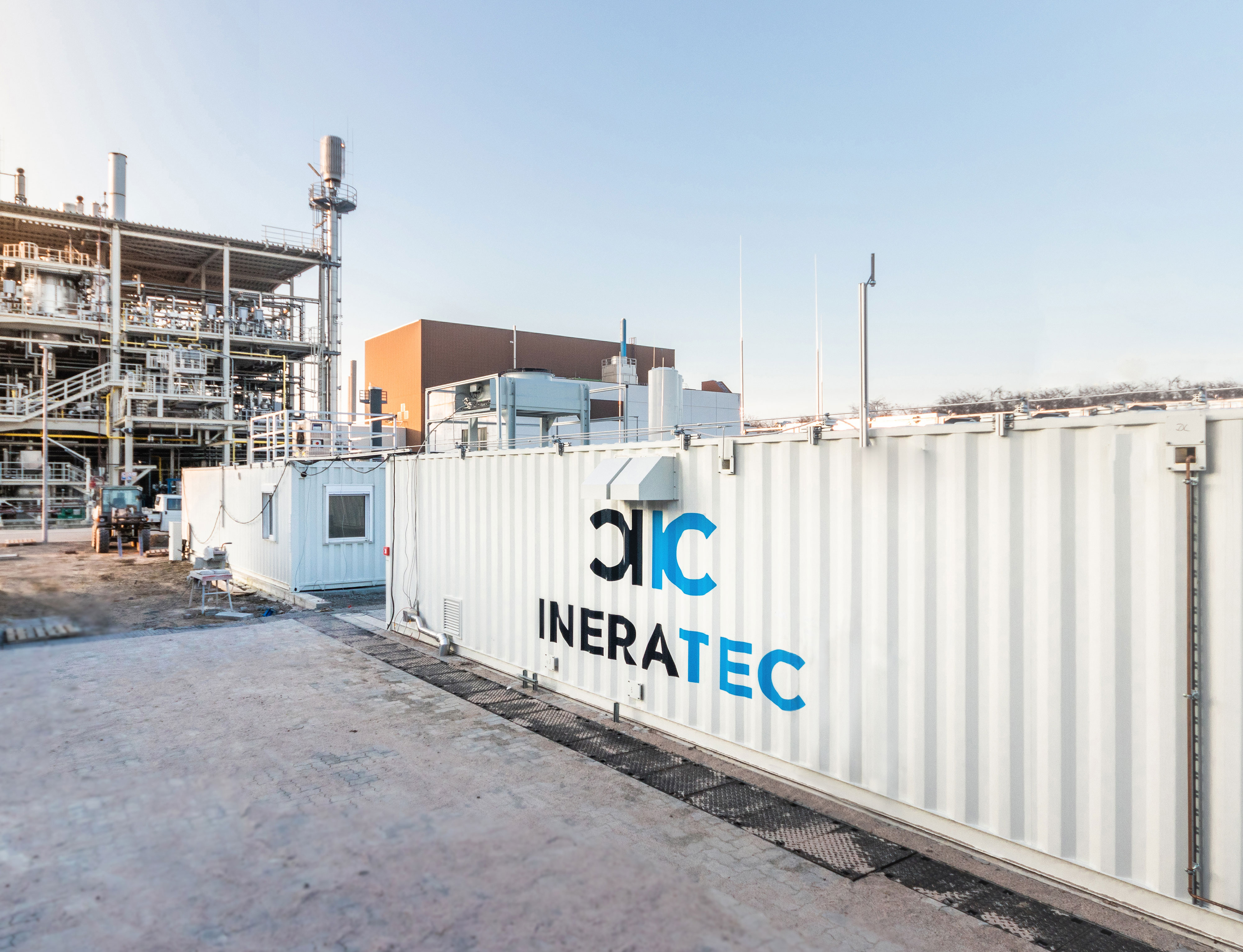Main navigation
Fuel from CO2 – compact decentralised facilities enable emission-free mobility
Can greenhouse gases like CO2 and methane be used to fuel cars? What sounds like wishful thinking is in fact already reality at INERATEC. The company’s compact mobile systems equipped with a unique chemical reactor technology are attracting worldwide interest. The systems enable CO2-free mobility for road traffic, aviation and shipping. Is this development close to successful market entry?
Transport accounts for around one fifth of climate-damaging emissions1,2. Electric drives are only a solution if they are powered by renewable energy sources. INERATEC, a spin-off from the Karlsruhe Institute of Technology (KIT), has developed an alternative to fuel energy sources, especially for use in long-haul traffic. The trick: the process can be used anywhere where renewable energy is generated and can react flexibly to natural supply fluctuations.
The idea for a world first

Using regenerative energy sources such as solar energy, wind energy or hydropower, the Karlsruhe start-up produces synthetic fuels with the highest possible energy density from CO2. In a first step, i.e. electrolysis, hydrogen is generated from renewable electricity and then mixed with CO2 and turned into synthesis gas. Synthesis gas is subsequently converted into hydrocarbons using a technique known as Fischer-Tropsch synthesis. The resulting hydrocarbons can be converted into synthetic fuels such as gasoline, kerosene or diesel (e-fuels, powerfuels). This then achieves so-called CO2-neutral mobility. Although CO2 is produced during combustion, it was previously removed from the atmosphere, thereby creating a cycle. In addition, solid hydrocarbons can be produced, inter alia, for use in the chemical industry. The special feature is that the plants powering the complete process have shrunk to a compact format thanks to an innovative reactor technology. The plants can be integrated into standard shipping containers that can be used on a mobile basis worldwide. Compared to large-scale chemical plants, the processes can be implemented cost-effectively and in a significantly shorter time period.
"The key point of our idea is to convert harmful environmental gases into liquid energy sources and thereby help make mobility and the chemical industry more sustainable,” says Dr.-Ing. Tim Böltken. Böltken and the company’s two other cofounders, Philipp Engelkamp and Dr.-Ing. Paolo Piermartini, recognised the potential of decentralised production of liquid energy sources from gases as early as 2015, and, since the establishment of the KIT spin-off in 2016, have directed the company firmly in this direction. The heart of the plant, a reactor only about 50 cm3 in diameter, has a sophisticated microstructure with a huge surface, corresponding to the size of three football pitches. It is here where Fischer-Tropsch synthesis takes place. "Depending on the customer's requirements, we can design and duplicate the modules based on a modular system or even set up several containers," Tim Böltken says.
INERATEC received the German Founders Award 2018, among other awards, for the successful development of this process for converting CO2 into carbon-neutral fuel and for the idea of mass-producing decentralised plants in the same way as cars are mass produced. The Karlsruhe-based company has already sold more than ten pilot and process plants that target different areas, but all with the core issue of decentralisation. "The future is not large power plants, but locally available energies such as solar power, wind and water power or energy from biogas and sewage treatment plants," said Böltken. "A central problem related to energy transition is the lack of energy storage. This is precisely our starting point. Our plants can be placed anywhere where previously unused energy and raw materials accumulate and the energy can then be stored in the form of liquid and solid hydrocarbons."
Liquid fuel from renewable resources

The EnBW subsidiary Energiedienst Holding AG and Audi AG generate carbon-neutral fuels directly at the hydroelectric power station in Laufenburg, Switzerland3. The power-to-liquid project is a world first in this particular form: surplus electricity from hydropower can be stored and used in the form of e-fuels to drive vehicles with conventional combustion engines. The plant, which consists of three containers and a transformer house, has a capacity of approximately 500,000 litres of synthetic fuel per year, and “recycles” approximately 1,000 tonnes of CO2. Since the CO2 comes from exhaust gases produced by biogenic plants, the e-diesel produced is combusted in a carbon-neutral way. Another advantage of the plant is that the stream-based liquid fuels contain no pollutants; their combustion generates hardly any sulphur residues. In addition, the process creates heat that can be used for industrial plants and heating.
INERATEC’s pilot plant in Finland started operating back in 2016 with the aim of publicly demonstrating the process on a decentralised scale as a trendsetting technology. Another power-to-liquid plant in Karlsruhe, established as part of Energy Lab 2.0, is designed to produce synthetic kerosene (e-kerosene®) from renewable electricity and CO2.
Using CO2 profitably instead of combusting it an environmentally harmful way
Renewable methane-containing gases as well as fossil and surplus gases can be converted into synthetic hydrocarbons using the gas-to-liquid (GTL) technology. Amongst other things, methane is released as a by-product of oil and gas production and combusted, especially if the recycling and transport costs exceed the expected revenue. Satellite data showed that around 150 billion cubic metres of gases associated with crude oil production were flared worldwide in 2013, corresponding to around 30% of the European Union's gas consumption4,5. In future, INERATEC's process has the potential to contribute to zero flaring, and instead use the biogas to produce storable and transportable long-chain hydrocarbons. Even renewable sewage gas, landfill gas and biogas, which are currently combusted in cogeneration plants, can be transformed into fuels with a very high energy storage capacity.
Power-to-gas – focusing on excess gas
Electrical energy is available on a large scale when there is a lot of wind and sun. "We use the power that is not fed into the public grid to convert electrolytically generated hydrogen and environmentally harmful CO2 into high-quality synthetic gas using our power-to-gas technology,” says Böltken. In the long term, electricity can thus be stored in the chemical energy carriers or fed into existing pipelines.
INERATEC, along with a Spanish energy company called Naturgy, are focusing on achieving a closed carbon dioxide cycle in a plant that was erected in Barcelona in 2018. The plant uses wind power and CO2 from sewage sludge. The renewable gas that is produced can be stored in the gas infrastructure and transported throughout Spain.
Not just ground transport: synthetic fuels are also suitable for air transport
Flying requires a lot of energy. At present, electromobility does not seem to work for aviation and shipping. Working with INERATEC and other industry and research partners in the “Copernicus 2PX” project, KIT is focusing on changing this situation using a filter system developed by a company called Climeworks. The company’s direct air capture filter system sucks in ambient air and the CO2 is bound to a chemical filter. Regenerative hydrogen produced with Siemens’ electrolysis technology is used to produce synthesis gas. In a second step, these two technologies combined lead to nearly carbon-neutral fuel. During the three-year-pilot phase, the researchers hope to produce 200 to 300 litres of fuel a day; preindustrial plants will subsequently be able to produce 2,000 l/day. The German Aerospace Center (DLR) is investigating the quality of synthetic fuels. Using computer simulations and based on electricity market data, the project partners Siemens, Bauhaus Luftfahrt and TU Hamburg-Harburg are analysing energy systems. The project was launched in late 2018, and is funded by the German Federal Ministry of Economics and Technology (BMWi).
"It is important for us to make decisive progress in our endeavor to shift from fossil to regenerative fuel," says Böltken. The tremendous potential of INERATEC technology has already been recognised by many institutions worldwide. In future, INERATEC plants will be established in Brazil, Malaysia and Canada. Silicon Valley has also expressed interest in the system. "We hope to be able to continue growing, both here in Germany and abroad.” The Karlsruhe-based company is currently looking for more customers, technology investors and supporters. Tim Böltken says that the central focus is production. "Even though we have reached market maturity, we want to produce more efficiently so that we can offer even more cost-effective systems." The foundation stone has been laid, the further development opportunities are exciting. After all, the more flexibly renewable resources can be used, the more efficient the entire energy system will become.
Literature:
1 https://www.umweltbundesamt.de/themen/klima-energie/klimaschutz-energiepolitik-in-deutschland/treibhausgas-emissionen/die-treibhausgase und https://www.umweltbundesamt.de/daten/klima/treibhausgas-emissionen-in-deutschland/kohlendioxid-emissionen#textpart-1
2 PM KIT 12/19, und https://www.ndr.de/ratgeber/Klimagase-Deutschland-stoesst-zu-viel-CO2-aus,kohlendioxid146.html=Bundesumweltministerium 2016
3 https://www.energiedienst.de/produktion/wasserstoff/power-to-liquid/
4 Peggy Schulz, Verena Leckebusch, Jürgen Messner, Harald Andruleit: Nutzen statt Abfackeln von Erdölbegleitgas – Chancen und Herausforderungen für Entwicklung und Treibhausgasminderung. Bundesanstalt für Geowissenschaften und Rohstoffe (BGR), Hannover 2013
5 Nicola Armaroli, Vincenzo Balzani, Nick Serpone: Powering Planet Earth. Energy Solutions for the Future. Weinheim 2013, p. 36.